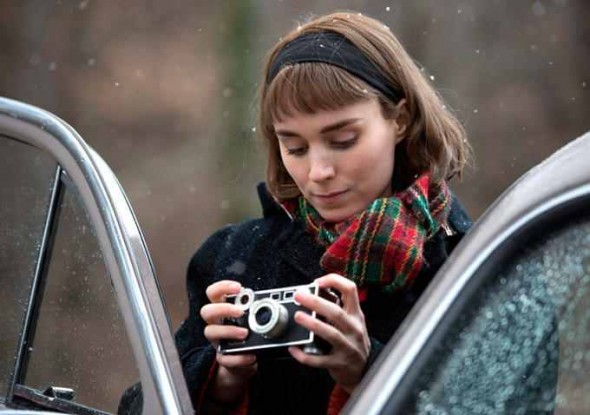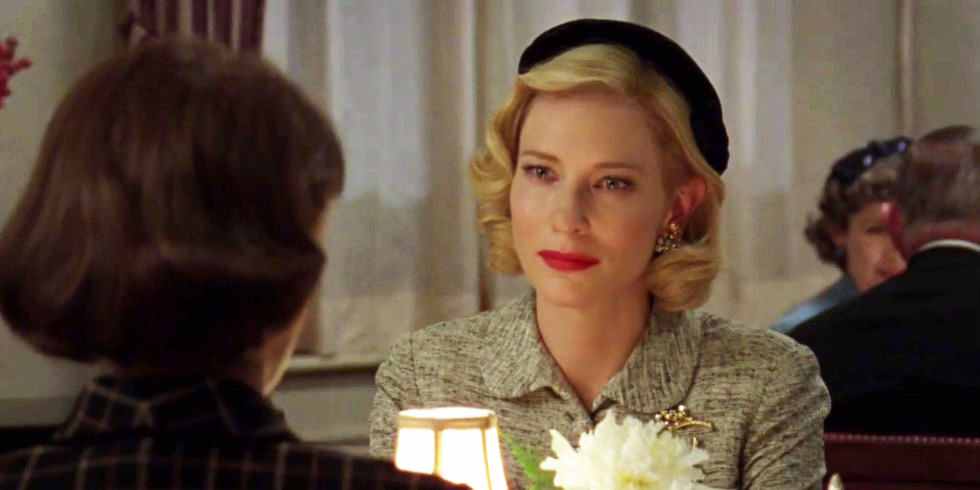If only Carol, the much lauded movie from director Todd Haynes (adapted by Phyllis Nagy from Patricia Highsmith’s novel The Price of Salt) were as good as its trailer, a one minute ten second masterpiece of close-ups, pitch-perfect period detail and barely contained emotion. On paper Carol is a film I should worship, a love story about queer women, based on a novel by a queer woman and adapted into a screenplay by one. And its director is one of the few people who came out of the new queer cinema of the early ’90s who still works regularly in film.
Haynes’ previous theatrical release I’m Not There was a miraculous rendering of everything I otherwise hate — bio-pics about musicians, Bob Dylan fandom, films set in the Old West and disjointed narratives — into a transcendent viewing experience. Not everything in I’m Not There made sense (no one but Haynes himself seemed to know what was going on in the scenes with the young Black child traveling with a guitar) but when the weird-ass chances Haynes took worked, like casting Cate Blanchett as the Dylan of the mid-1960s, or having a band (made up of current indie musicians) in the Old West section of the film sing “Going To Acapulco” to a corpse propped up on a stage with them, the results were as thrilling as they were original.
I should have known Carol wasn’t for me when, before I had a chance to see the film (which took a month to make its way to my art-house friendly city — and is still in relatively few theaters compared to macho Oscar-bait The Revenant) some well-known, straight women critics who waxed rhapsodic about Carol compared the relationship between young department store clerk Therese (Rooney Mara) and older, married, wealthy housewife Carol (Cate Blanchett) with that of a mother and daughter — or a mentor and her protégé. Even if these critics meant well, their mindset de-sexes queer women (something straight people have a history of doing). What love affairs between women most resemble are… other love affairs. And what any couple needs, if the audience is going to root for them in a film, is chemistry, not vague bonding around sisterhood and lipstick.
As iconic-looking Blanchett is in early ’50s hair and costumes (by Sandy Powell) her performance is so over-the-top she takes us completely out of the movie. Evident even in stills, the way she looks at Mara is how an alien from outer space ready to tear off its human disguise to swallow her whole might, a gaze not dissimilar from the one Blanchett, playing the stepmother, directed toward Cinderella.
In much of Carol Blanchett’s performance she seems to be telegraphing the audience, “I’m acting! In real life, I’m not queer at all,” continuing an ignoble tradition that includes two other talented, blonde movie stars: William Hurt in Kiss of the Spider Woman (which won him an Oscar) and Philip Seymour Hoffman in Flawless. By 2006, when Hoffman won his Oscar for playing Truman Capote without histrionics, I thought the old method of playing queer characters had gone out of style for good. In brief moments of Carol we see Blanchett reach under the broad surface of the character. Toward the end, in her speech to a room full of lawyers about custody of her daughter she touches us, and early on, when Therese is talking to Carol on a hallway phone and tries to confirm if she’s reading Carol’s interest in her correctly we see Carol’s vulnerability. Therese says, “I wanna ask you things, but I’m… I’m not sure that you want that…,” and Carol pleads in desperation, “Ask me, things… Please…” But through most of this film Blanchett doesn’t mine the depth of feeling the film’s story demands.
Mara’s performance is much more natural, but because she’s playing against Blanchett’s hamminess, her wide-open stare registers more like that of a schoolgirl who hasn’t done her homework gaping at her teacher than the obsessive protagonist of Highsmith’s novel who, on impulse, sends beautiful, rich, Carol a Christmas card after briefly helping her in the store. In the film, Therese instead sends Carol back the gloves she left on the store counter, making the main character (and no matter how the producers campaigned for the film’s acting award nominations, Therese is the main character of both the novel and the movie) more timid and dull. The film’s Therese is also stripped of ambition: the character in the novel, an aspiring set designer, is often networking with people who might be in the position to employ her or ones who can introduce her to someone who can — and never misses a chance to take on a set-designing job, not even to be with Carol. The Therese in the film takes photos and has to be pushed and prodded (by a man, even though in the 1950s, most men were not exactly eager to encourage women in their careers as artists) to have any faith in her own talent. We also aren’t privy to her thoughts as we are in the novel, so we don’t know that even as she remains quiet she’s taking everything in and making shrewd (and sometimes cruel) observations.
Sarah Paulson as Carol’s ex, Abby, is a relief in no small part because Paulson, an out performer who has never seemed fully at ease in previous big screen roles, knows she doesn’t have to overplay to convey the bond between the women. When Abby and Carol talk, Paulson’s smartypants smile and skeptical eyes show the two have the ease of people who have long since forgiven each other’s transgressions. Paulson also reminded me that my favorite part of Far From Heaven, Haynes’ other ’50s set, Douglas-Sirk-inspired drama, was Patricia Clarkson as another wisecracking best friend.
Haynes has in Carol (with art direction by Jesse Rosenthal and cinematography by Edward Lachman) perfected the look of a Sirk melodrama while modernizing it, with the more “realistic” hyper-pigmented reds and mint-greens of 1950s-era color photos along with the fuzzy resolution of snapshots taken at that time. But Haynes seems not to have learned the first lesson from Sirk’s films (or from two other gay male directors influenced by Sirk: Rainer Werner Fassbinder and Pedro Almodóvar): tastefulness is the opposite of passion. When Blanchett and Mara have one of countless drinks together, without any part of their bodies “accidentally” touching the other’s, when the film avoids any on-camera exchange of confidences (which do happen in the novel and the screenplay: a blossoming romance between women doesn’t need both touch and talk, but it does need one or the other) the audience doesn’t experience tension, just boredom.
When the sex scene finally happens, it plays like something from adolescent fanfiction, after a makeover, when the two women stare steadily and silently at each other in a mirror. We then get tasteful toplessness and (finally) some touching (strictly above the waist) from the two leads. In the novel, which includes neither the makeover nor the mirror, the two women have sex for the first time after they each say, “I love you.” And in roundabout, metaphorical, 1950s parlance Highsmith makes clear the sex is a revelation for Therese. The one redeeming part of the scene in the film is Carol looking at Therese’s naked body and almost smiling as she says, ” I never looked like that…”
What puzzles me most about Carol is: with so many queer people at its helm why does the film come off as enervated and somewhat clueless about queer issues (like Carol seeming to be sincere when she says she likes her therapist, when psychotherapy of the 1950s was invariably conversion therapy)? Carol pales in comparison to two other films centered around queer love stories which didn’t have openly queer people heading their productions: Brokeback Mountain and Blue Is The Warmest Color. Brokeback, which famously shows heated love scenes between its main characters, takes place at least partly post-Stonewall, but is a wrenching portrait of the closet’s effect on the couple. In Carol, even as its bittersweet “happy” ending is kept intact, the film doesn’t acknowledge that if the two women stay together, even in New York, even in “progressive” circles they’ll have to lie to nearly everyone (except other queer people) about their relationship for at least the next two decades (even Highsmith waited many years before she let the novel be republished under her own name, not the original pseudonym). And that secrecy took its toll on queer people, even those in happy relationships, as Edie Windsor (whose relationship with her eventual spouse started in New York over ten years after the one in the film) has stated in interviews. As bad as the naked sex scenes in Blue Is the Warmest Color were, that film did get right the thrill of queer first love (and lust), the sacrifices the main character made for it, and how few straight people she bothered to come out to, even in France, even in 2013.
The makers of Carol know a lot more about queer life than the director and co-writer of Blue does, but I think those behind Carol set out to make a film about queer characters that straight people can congratulate themselves for enjoying. The sex scenes will neither skeeve them out nor turn them on. The homophobia of the time (like that of more recent times — and of now) is softened, present only in characters we don’t feel invested in, so straight viewers are free to ooh and aah over the costumes, cinematography and art direction, guilt-free.
Of course plenty of queer people seem to enjoy this film too: the critics’ group I’m part of gave every award it could to Carol (after the Oscars snub of the film in “Best Picture” and “Best Director” categories). As someone who came of age in the ’80s and ’90s when many of us dutifully went to see every highly imperfect queer film released, I understand the tendency to want to support queer representation in movies. But I much prefer Haynes when he lets his freak flag fly, as in I’m Not There and when he speaks directly and knowingly to a queer audience as in Velvet Goldmine (which should be essential viewing for everyone mourning David Bowie right now). Maybe the lesson here is that Haynes’ features should always be period films about musicians. A glance at IMDb shows that his next film is an as-yet-untitled project about the life of Peggy Lee.
[youtube_sc url=”https://www.youtube.com/watch?v=fjHU34cpD1U” iv_load_policy=”3″]
___________________________________________________
Ren Jender is a queer writer-performer/producer putting a film together and a staff writer at Bitch Flicks. Last week at The Toast, she interviewed Deniz Gamze Ergüven, the writer-director of the Oscar nominee ‘Mustang’ which everyone should see.



something that is pretty much beside the point:
“[A]rt direction by Jesse Rosenthal” should actually read “production design by Judy Becker”. Art direction is an outdated term and it should be noted that Ms. Becker is the creative head with Mr. Rosenthal as the right hand.
Like I said, beside the point, but a scholarly discussion of contemporary film should get this right.